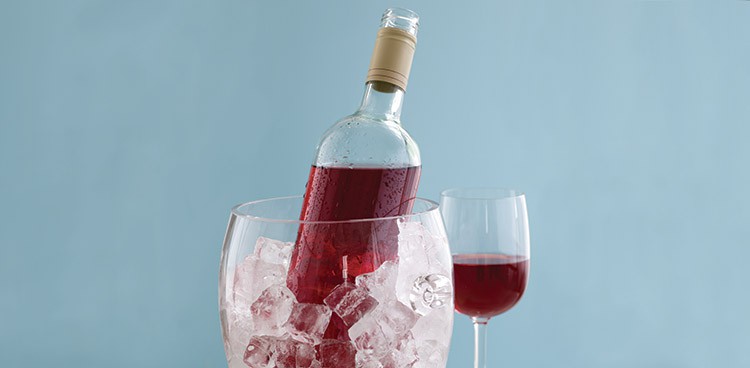
Attention, diners: You may chill red wines.
Many people would have you think otherwise – like the waiter who balked when my dining companion, a winemaker, asked for an ice bucket to accompany a bottle of red Bordeaux we were enjoying on a 90˚F day. But never mind the doubters: When temperatures are high, you have every reason to put red on ice.
This is particularly relevant considering a new wave of fresh, bright reds from serious wine producers. Call it high-quality glou-glou (French onomatopoeia for “glugable”)—wines like Glou from Rhône vintner Jean Delobre, Trinch! (named for the sound of wine glasses clinking) from the Bretons in France’s Loire, or Bebame, meaning “drink me” in Spanish, a California collaboration between Edmunds St. John and Don Heistuman.
These wines may have humorous names, but they aren’t plonk. Instead, they value freshness over richness. Some make the best of fruit off young vines, which tends to be less complex than that of older vines; others are made to show off a grape variety that simply isn’t big and bold.
In most cases, these wines tend to be made straightforwardly, without leaving the grape juice to macerate with skins for weeks on end in an effort to extract all color, flavor, and tannins. Rather, they’re all about fruit and earth: Simple expressions of themselves.
These wines are a boon with cheese, offering red fruit flavors that still give a clear view to a cheese’s complex components. Plus, cheese generally likes acidity—it’s what helps cut through milk fat. And acidity likes acidity, thus why green salads go best with high-acid wines, why goat cheese loves a good crisp sauvignon blanc, and why tangy manchego pairs with classic Spanish rioja. Rich, low-acid wines feel insufferably flabby in the face of acidic foods.
To keep that acidity vibrant and fruit flavors fresh, a quick chill is invaluable. Think of the difference between a sunwarmed plum and one that’s been lightly chilled. The sun-warmed plum may be luxuriously soft and juicy, but it’s on the downhill side of its life, losing freshness before your eyes. A light chill preserves its freshness, extends its energy. Ditto with wine: Colder temperatures accentuate wine’s acidity, making the fruit taste more taut and vibrant—in sum, more drinkable.
Conversely, an ice-cold red won’t smell like anything, as it’ll be too cold to let off aromatic volatile compounds. And if it doesn’t smell like anything, it’s not going to taste like anything, either. But this is an easy dilemma to address: Let a freshly poured glass sit at room temperature for a few minutes or warm the bowl of the glass with your hands.
High-acid, bright, lighter-bodied reds are found in cold areas, places where grapes don’t ripen easily and the sun doesn’t shine so hard it burns off their acidity: Upstate New York, for example, or the far Sonoma Coast; Galicia and France’s Jura, a region high in the Alps more famed, perhaps, for its Comté. Or look for grapes that come by their lightness naturally. Jura’s trousseau varietal is made in California, where the grape has been grown since the 1800s under the name “bastardo.” Only recently did vintners figure out its true identity, and they’re making gauzy, earthy reds from it.
Think of lambrusco, made into spicy, purple-fruited bubblies perfect for sipping while eating chunks of salty Parmigiano Reggiano; gamay, Beaujolais’s fruity grape, or valdiguié, long mistaken for gamay in California and now finally getting its due. Choose reds that are bottled young and fresh, with no extended time in wooden barrels. You may save yourself some money over the fancier, barrel-aged versions on the wine store shelf, but you’ve found a tastier match for a summer cheese plate.
6 high-acid reds for cheese
- ARNOT-ROBERTS LAKE COUNTY LUCHSINGER VINEYARD TROUSSEAU, a pale red made from a grape introduced by Portuguese settlers, is fitting with St. George, a young cow’s milk cheese made by the Portuguese-run Matos Cheese Factory in Santa Rosa, Calif.
- BEBAME RED, a California blend of cabernet franc with a splash of cherrybright gamay, is gentle enough for a bloomyrind cheese like Brie.
- JEAN DELOBRE LA FERME DES SEPT LUNES GLOU GAMAY is fragrant as a forest with an earthy funk that brings to mind pairings with washedrind cheeses.
- TAMÍ FRAPPATO SICILIA ROSSO packs an effusive punch of floral strawberry flavor. Chill it lightly to serve with a fresh mozzarella and tomato salad.
- R. LÓPEZ DE HEREDIA VIÑA TONDONIA RIOJA RESERVA is an oldschool rioja, packed with complexity yet brisk and transparent, a terrific accompaniment to manchego.
- MIONETTO IL LAMBRUSCO DELL’EMILIA – purple-fruited, lightly bubbly, and totally dry— is a classic pairing with salty-sweet Parmigiano Reggiano.






